Search
- Page Path
-
- HOME
- Search
- Original Article
- Pulmonology
- Effect of vitamin C supplement in treatment of childhood pneumonia requiring hospitalization: a randomized controlled trial
- Chutima Phuaksaman, Katechan Jampachaisri, Klaita Srisingh
- Clin Exp Pediatr. 2025;68(9):690-699. Published online April 1, 2025
-

This study assessed the effects of vitamin C on children with community-acquired pneumonia (CAP). Vitamin C supplementation improved clinical symptoms within 48–72 hours compared to placebo but did not reduce the length of hospital stay (LOS). These findings suggest that vitamin C is beneficial for managing CAP severity, but does not affect LOS.
- Review Article
- Infection
- Community-acquired pneumonia in children: updated perspectives on its etiology, diagnosis, and treatment
- Ki Wook Yun
- Clin Exp Pediatr. 2024;67(2):80-89. Published online June 14, 2023
-

· Most commonly confirmed causes of community-acquired pneumonia (CAP) in children are Mycoplasma pneumoniae (8%–40%) and respiratory syncytial virus (15%–20%).
· Pyogenic bacteria, most commonly Streptococcus pneumoniae (40%–50%) and Streptococcus pyogenes (10%–25%), are detected in 2%–5% of children hospitalized with CAP.
· CAP should be diagnosed conservatively according to clinical and radiological criteria.
· The etiology should be identified via appropriate test result interpretation.
- Pulmonology
- Epidemiology and surveillance implications of community-acquired pneumonia in children
- Eui Jeong Roh, Jung Yeon Shim, Eun Hee Chung
- Clin Exp Pediatr. 2022;65(12):563-573. Published online October 17, 2022
-
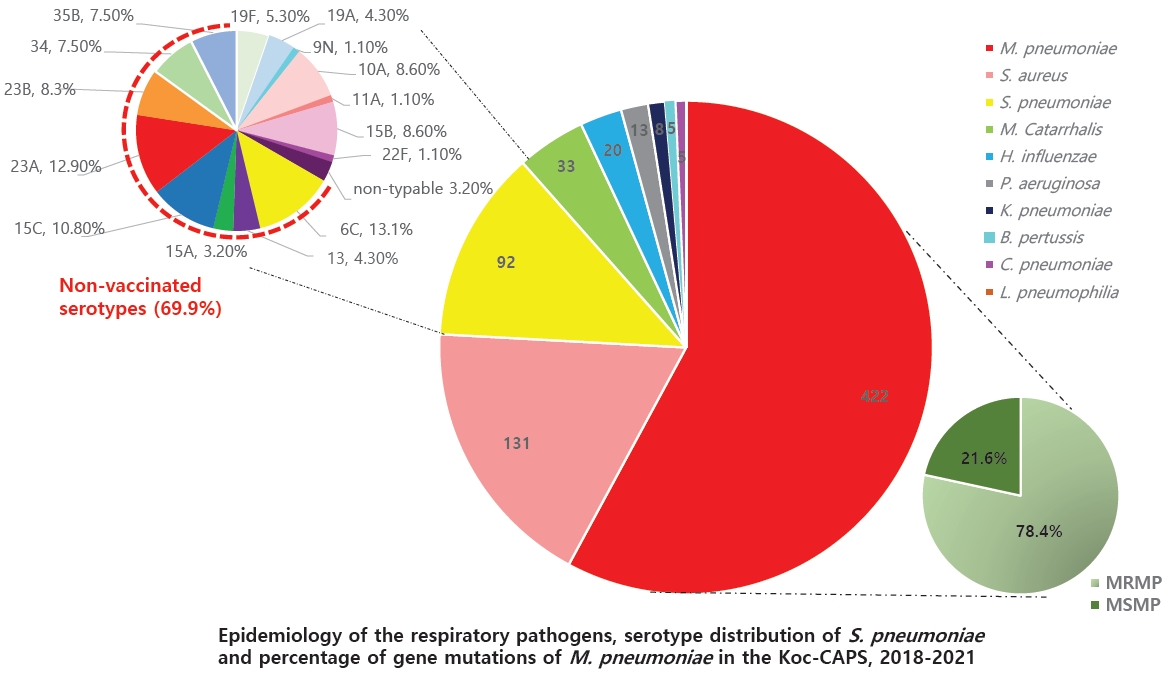
The identification of the causative pathogens of community-acquired pneumonia and appropriate treatment and prevention can reduce mortality and the socioeconomic burden by reducing the medical expenses. The world has been in the coronavirus disease 2019 pandemic since 2020, and there is always a risk of continuous emergence and epidemic of new respiratory infectious diseases. Therefore, it is important to sustain a monitoring system for respiratory infectious diseases including pneumonia.
- Original Article
- Infection
- Role of lung ultrasound patterns in monitoring coronavirus disease 2019 pneumonia and acute respiratory distress syndrome in children
- Satyabrata Roychowdhoury, Subhajit Bhakta, Manas Kumar Mahapatra, Saptarshi Ghosh, Sayantika Saha, Mithun Chandra Konar, Mihir Sarkar, Mousumi Nandi
- Clin Exp Pediatr. 2022;65(7):358-366. Published online May 13, 2022
-
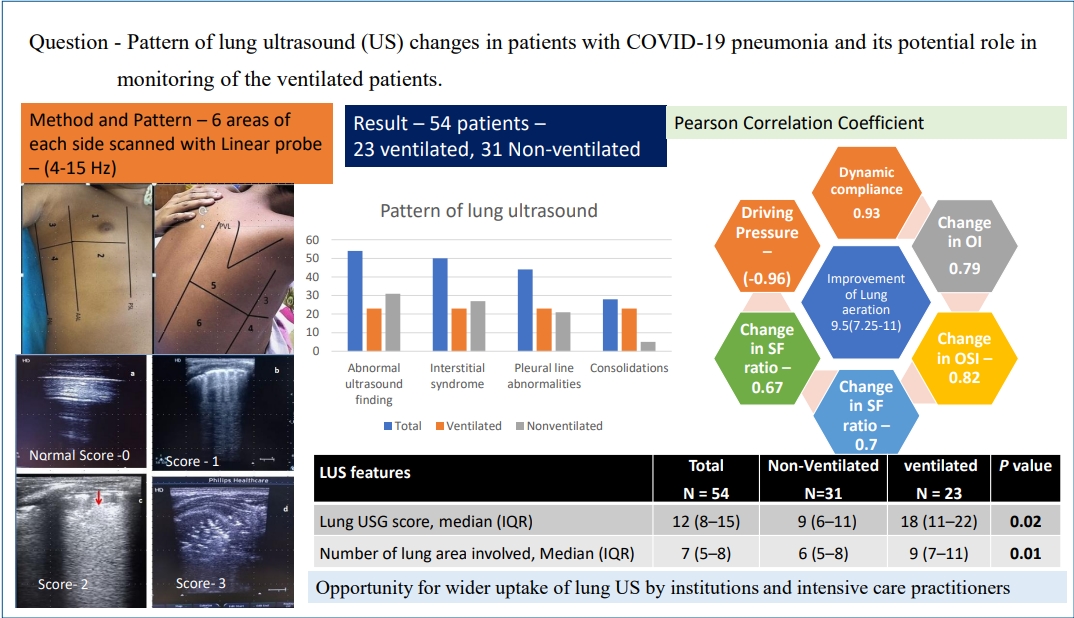
Question: Potential role of patterns of lung ultrasonography (US) in monitoring changes in mechanically ventilated patients with coronavirus disease 2019 (COVID-19) pneumonia.
Finding: Interstitial syndrome, an irregular pleural line, and peripheral microconsolidation were the most prevalent findings. Changes in lung aeration after mechanical ventilation corelated with improved oxygenation. A fall in lung ultrasound reaeration score ≤ 5 may predict successful weaning.
Meaning: Lung US is gaining wider utility for monitoring COVID-19 pneumonia.
- General Pediatrics
- Risk factors for childhood pneumonia: a case-control study in a high prevalence area in Indonesia
- Vivi Ninda Sutriana, Mei Neni Sitaresmi, Abdul Wahab
- Clin Exp Pediatr. 2021;64(11):588-595. Published online March 15, 2021
-
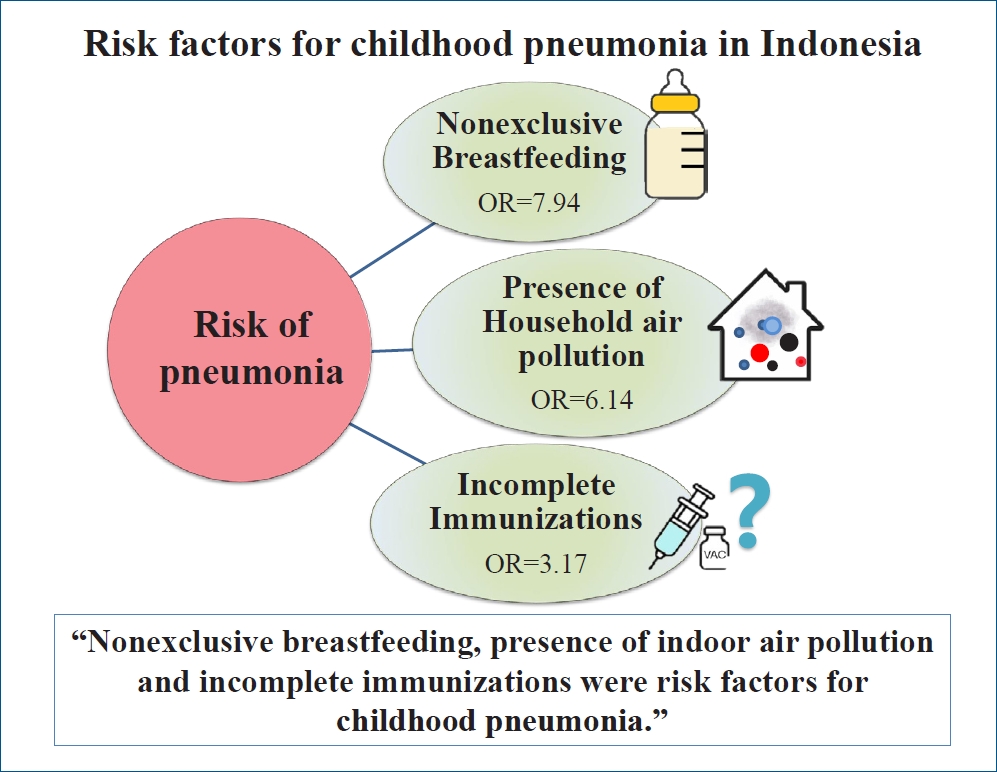
Question: Is the incidence of childhood pneumonia influenced by breastfeeding and basic immunization status?
Finding: Exclusive breastfeeding and complete basic immunization status have an effect in limiting the incidence of childhood pneumonia.
Meaning: While exclusive breastfeeding and complete basic immunization the Expanded Program on Immunization status are important factors for reducing the incidence of childhood pneumonia, indoor air pollution was also a significant risk factor.
- Review Article
- Infection
- Consideration in treatment decisions for refractory Mycoplasma pneumoniae pneumonia
- Hye-Kyung Cho
- Clin Exp Pediatr. 2021;64(9):459-467. Published online February 10, 2021
-

• To avoid unnecessary exposure to secondary antibiotics, it is needed to diagnose Mycoplasma pneumoniae (MP) pneumonia carefully, especially when unresponsiveness to macrolide is suspected.
• Serologic and molecular tests for MP infection and excluding respiratory infection caused by other pathogens might be considered.
• It is necessary to continuously monitor antibiotic susceptibility of MP, and efforts to lower antibiotic pressure are required.
- Pulmonology
- Current perspectives on atypical pneumonia in children
- Jung Yeon Shim
- Clin Exp Pediatr. 2020;63(12):469-476. Published online June 10, 2020
-

Macrolides are the first line treatment in atypical pneumonia caused by M. pneumoniae, C. pneumoniae, and L. pneumophila. Macrolide-resistant mycoplasma pneumonia (MRMP) is emerging worldwide, especially in East Asia. Immune modulators such as corticosteroids or second line antibiotics are treatment options for MRMP. Pediatricians should be careful with empirical therapy of macrolides in children with mild to moderate community-acquired pneumonia not to increase the risk of MRMP.
- Original Article
- Immunology
- Immunogenicity and safety of a 12-valent pneumococcal conjugate vaccine in infants aged 6–10 weeks: a randomized double-blind active-controlled trial
- Jonghoon Shin, Jamaree Teeratakulpisarn, Thanyawee Puthanakit, Tuangtip Theerawit, Ji Hwa Ryu, Jinhwan Shin, Seulgi Lee, Hayoung Lee, Kyungjun An, Hun Kim
- Clin Exp Pediatr. 2020;63(7):265-271. Published online December 6, 2019
-
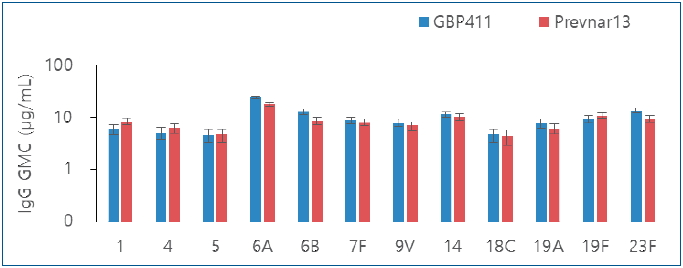
Question: The immunogenicity and safety of GBP411 when administered to healthy infants are not understood.
Finding: The intergroup differences were not significant for all 12 serotypes after the booster dose. The overall incidence of solicited local adverse events between the groups did not differ significantly.
Meaning: GBP411 with a 2p+1 dosing schedule induced a substantial immune response, and may be safe for administration to healthy infants.
- Review Article
- Pulmonology
- Benefits and risks of therapeutic alternatives for macrolide resistant Mycoplasma pneumoniae pneumonia in children
- Hyeon-Jong Yang
- Clin Exp Pediatr. 2019;62(6):199-205. Published online March 15, 2019
-

Although Mycoplasma pneumoniae pneumonia (MPP) has been generally susceptible to macrolides, the emergence of macrolide-resistant MPP (MRMP) has made its treatment challenging. MRMP rapidly spread after the 2000s, especially in East Asia. MRMP is more common in children and adolescents than in adults, which is likely related to the frequent use of macrolides for treating M. pneumoniae infections in children....
- Original Article
- Pulmonology
- The changes of prevalence and etiology of pediatric pneumonia from National Emergency Department Information System in Korea, between 2007 and 2014
- Eun Ju Shin, Yunsun Kim, Jin-Young Jeong, Yu Mi Jung, Mi-Hee Lee, Eun Hee Chung
- Clin Exp Pediatr. 2018;61(9):291-300. Published online September 15, 2018
-

Purpose: Understanding changes in pathogen and pneumonia prevalence among pediatric pneumonia patients is important for the prevention of infectious diseases. Methods: We retrospectively analyzed data of children younger than 18 years diagnosed with pneumonia at 117 Emergency Departments in Korea between 2007 and 2014. Results: Over the study period, 329,380 pediatric cases of pneumonia were identified. The most frequent age group was...
- Increased procalcitonin level is a risk factor for prolonged fever in children with Mycoplasma pneumonia
- Ji Eun Jeong, Ji Eun Soh, Ji Hee Kwak, Hye Lim Jung, Jae Won Shim, Deok Soo Kim, Moon Soo Park, Jung Yeon Shim
- Clin Exp Pediatr. 2018;61(8):258-263. Published online August 15, 2018
-
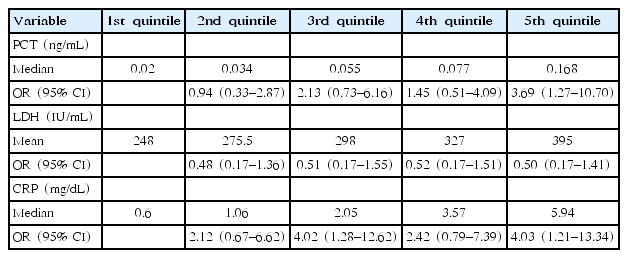
Purpose: Macrolide-resistant Mycoplasma pneumoniae pneumonia (MPP) is characterized by prolonged fever and radiological progression despite macrolide treatment. Few studies have examined serum procalcitonin (PCT) level in children with MPP. We aimed to investigate the association of acute inflammation markers including PCT with clinical parameters in children with MPP. Methods: A total of 147 children were recruited. The diagnosis of MPP...
- Review Article
- Pulmonology
- Mechanism of resistance acquisition and treatment of macrolide-resistant
Mycoplasma pneumoniae pneumonia in children - Hyeon-Jong Yang, Dae Jin Song, Jung Yeon Shim
- Clin Exp Pediatr. 2017;60(6):167-174. Published online June 22, 2017
-

Mycoplasma pneumoniae pneumonia (MPP) is one of the most common forms of community-acquired pneumonia in children and adolescents. Outbreaks of MPP occur in 3- to 7-year cycles worldwide; recent epidemics in Korea occurred in 2006–2007, 2011, and 2015–2016. Although MPP is known to be a mild, self-limiting disease with a good response to macrolides, it can also progress into a...
- Original Article
- Pulmonology
- Prevalence and clinical manifestations of macrolide resistant
Mycoplasma pneumoniae pneumonia in Korean children - Eun Lee, Hyun-Ju Cho, Soo-Jong Hong, Jina Lee, Heungsup Sung, Jinho Yu
- Clin Exp Pediatr. 2017;60(5):151-157. Published online May 31, 2017
-
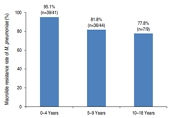
Purpose Macrolide resistance rate of
Mycoplasma pneumoniae has rapidly increased in children. Studies on the clinical features between macrolide susceptible-M. pneumoniae (MSMP) and macrolide resistant-M. pneumoniae (MRMP) are lacking. The aim of this study was to identify the macrolide resistance rate ofM. pneumoniae in Korean children withM. pneumoniae penupmonia in 2015 and compare manifestations between MSMP and MRMP.Methods Among 122...
- Case Report
- Genetics and Metabolism
- A rare case of Sjogren-Larsson syndrome with recurrent pneumonia and asthma
- Azita Tavasoli, Shirin Sayyahfar, Babak Behnam
- Clin Exp Pediatr. 2016;59(6):276-279. Published online June 30, 2016
-
Sjogren-Larsson syndrome (SLS) is a rare autosomal recessive neurocutaneous disorder with worldwide incidence of 0.4 per 100,000 people. It is characterized by the triad of congenital ichthyosis, spastic diplegia or quadriplegia, and mental retardation. Herein we report a 2-year-old male child with SLS, asthma, and recurrent pneumonia. SLS was confirmed by a molecular genetics study that revealed a deletion mutation...
- Original Article
- Infection
Pneumocystis jirovecii pneumonia in pediatric patients: an analysis of 15 confirmed consecutive cases during 14 years- Kyung-Ran Kim, Jong Min Kim, Ji-Man Kang, Yae-Jean Kim
- Clin Exp Pediatr. 2016;59(6):252-255. Published online June 30, 2016
-
Purpose Pneumocystis jirovecii pneumonia occurs in various immunocompromised patients. Despite the prophylaxis strategies in clinical practice, certain patients developP. jirovecii pneumonia. This study was performed to investigate pediatric cases withP. jirovecii pneumonia in a single center.Methods We identified pediatric patients younger than 19 years with microbiologically confirmed
P. jirovecii pneumonia from January 2000 to February 2014. A retrospective chart review...
- Case Report
- Neurology
- Complete occlusion of the right middle cerebral artery associated with
Mycoplasma pneumoniae pneumonia - Ben Kang, Dong Hyun Kim, Young Jin Hong, Byong Kwan Son, Myung Kwan Lim, Yon Ho Choe, Young Se Kwon
- Clin Exp Pediatr. 2016;59(3):149-152. Published online March 31, 2016
-
We report a case of a 5-year-old girl who developed left hemiparesis and left facial palsy, 6 days after the initiation of fever and respiratory symptoms due to pneumonia. Chest radiography, conducted upon admission, showed pneumonic infiltration and pleural effusion in the left lung field. Brain magnetic resonance imaging showed acute ischemic infarction in the right middle cerebral artery territory....
- Original Article
- Emergency Medicine
- A nationwide study of children and adolescents with pneumonia who visited Emergency Department in South Korea in 2012
- Chang Hyu Lee, Youn Kyoung Won, Eui-Jung Roh, Dong In Suh, Eun Hee Chung
- Clin Exp Pediatr. 2016;59(3):132-138. Published online March 31, 2016
-
Purpose Acute respiratory infection, particularly pneumonia, is the most common cause of hospitalization and death among children in developing nations. This study aimed to investigate the characteristics of children and adolescents with pneumonia who visited Emergency Department (ED) in South Korea in 2012.
Methods We analyzed National Emergency Department Information System (NEDIS) records from 146 EDs in South Korea for all pediatric patients...
- Case Report
- The first pediatric case of tularemia in Korea: manifested with pneumonia and possible infective endocarditis
- Jung Sook Yeom, Kyuyol Rhie, Ji Sook Park, Ji-Hyun Seo, Eun Sil Park, Jae-Young Lim, Chan-Hoo Park, Hyang-Ok Woo, Hee-Shang Youn
- Clin Exp Pediatr. 2015;58(10):398-401. Published online October 21, 2015
-
Tularemia is a potentially severe zoonotic disease caused by
Francisella tularensis . A lack of awareness about tularemia can be embarrassing and could result in delayed treatment because of improper diagnosis. The diagnosis of tularemia is difficult, because the infections are rare and the clinical spectrum is broad. As only 1 adult case has been reported in Korea thus far, pediatricians...
- Original Article
- Hepatitis associated with
Mycoplasma pneumoniae infection in Korean children: a prospective study - Kyu Won Kim, Jae Jin Sung, Hann Tchah, Eell Ryoo, Hye Kyung Cho, Yong Han Sun, Kang Ho Cho, Dong Woo Son, In Sang Jeon, Yun Mi Kim
- Clin Exp Pediatr. 2015;58(6):211-217. Published online June 22, 2015
-
Purpose Mycoplasma pneumoniae (MP) infection is a major cause of respiratory infection in school-aged children. Extrapulmonary manifestations of MP infection are common, but liver involvement has been rarely reported. The aim of this study was to determine the clinical characteristics of MP-associated hepatitis.Methods This prospective study included 1,044 pediatric patients with MP infection diagnosed serologically with MP IgM at one medical center...
- Epidemiological comparison of three
Mycoplasma pneumoniae pneumonia epidemics in a single hospital over 10 years - Eun-Kyung Kim, You-Sook Youn, Jung-Woo Rhim, Myung-Seok Shin, Jin-Han Kang, Kyung-Yil Lee
- Clin Exp Pediatr. 2015;58(5):172-177. Published online May 22, 2015
-
Purpose Mycoplasma pneumoniae (MP) pneumonia epidemics have occurred in 3- to 4-year cycles in Korea. We evaluated the epidemiologic characteristics of MP pneumonia in Daejeon, Korea, from 2003 to 2012.Methods We retrospectively analyzed 779 medical records of children (0-15 years of old) with MP pneumonia admitted to our institution and compared the data from 3 recent epidemics.
Results In 779 patients, the mean age...
- Case Report
- Chronic Epstein-Barr virus infection causing both benign and malignant lymphoproliferative disorders
- Yoojin Kwun, Soo-Jong Hong, Jin Seong Lee, Da Hye Son, Jong Jin Seo
- Clin Exp Pediatr. 2014;57(9):420-424. Published online September 30, 2014
-
The Epstein-Barr virus (EBV) is oncogenic and can transform B cells from a benign to a malignant phenotype. EBV infection is also associated with lymphoid interstitial pneumonia (LIP). Here, we report the case of a 14-year-old boy who was diagnosed with a latent EBV infection and underlying LIP, without any associated immunodeficiency. He had been EBV-seropositive for 8 years. The...
- Original Article
- Increased risk of refractory
Mycoplasma pneumoniae pneumonia in children with atopic sensitization and asthma - Jeong Eun Shin, Bo Ram Cheon, Jae Won Shim, Deok Soo Kim, Hae Lim Jung, Moon Soo Park, Jung Yeon Shim
- Clin Exp Pediatr. 2014;57(6):271-277. Published online June 30, 2014
-
Purpose A nationwide outbreak of
Mycoplasma pneumoniae pneumonia (MP) refractory to macrolide antibiotics occurred in Korea during 2011. Steroid therapy has been reported to be both efficacious and well tolerated in pediatric patients with refractory MP. We compared clinical features and laboratory characteristics between children with refractory MP requiring steroid treatment and those with macrolide-responsive MP and evaluated the risk factors...
- Predictive value of C-reactive protein in response to macrolides in children with macrolide-resistant
Mycoplasma pneumoniae pneumonia - Young Ho Seo, Jang Su Kim, Sung Chul Seo, Won Hee Seo, Young Yoo, Dae Jin Song, Ji Tae Choung
- Clin Exp Pediatr. 2014;57(4):186-192. Published online April 30, 2014
-
Purpose The prevalence of macrolide-resistant
Mycoplasma pneumoniae (MRMP) has increased worldwide. The aim of this study was to estimate the proportion of MRMP in a tertiary hospital in Korea, and to find potential laboratory markers that could be used to predict the efficacy of macrolides in children with MRMP pneumonia.Methods A total of 95 patients with
M. pneumoniae pneumonia were enrolled in...
- Case Report
- Liver abscess due to
Klebsiella pneumoniae in a healthy 12-year-old boy - Da Hye Yoon, Yeon Jin Jeon, E Young Bae, Dae Chul Jeong, Jin Han Kang
- Clin Exp Pediatr. 2013;56(11):496-499. Published online November 27, 2013
-
Pyogenic liver abscess (PLA) is rare in healthy children. We report a case of PLA in an immunocompetent 12-year-old boy. Percutaneous catheter drainage was performed for the abscess. In addition, parenteral antibiotics were administered for 3 weeks.
Klebsiella pneumoniae was detected in the culture of blood and drained fluid. Here, we present this case and a brief review of the...
Mycoplasma pneumoniae associated stroke in a 3-year-old girl- Gun-Ha Kim, Won Hee Seo, Bo-Kyung Je, So-Hee Eun
- Clin Exp Pediatr. 2013;56(9):411-415. Published online September 30, 2013
-
Infectious diseases precede a significant proportion of acute ischemic strokes in children. Here, we report a case of acute ischemic stroke in a 3-year-old girl with a
Mycoplasma pneumonia -associated respiratory tract infection. She developed an acquired prothrombotic state of protein S deficiency and had increased fibrinogen and fibrinogen degradation product levels and increased titer of antinuclear antibodies. However, these conditions...
Klebsiella pneumoniae liver abscess in an immunocompetent child- Jang-Mi Kwon, Hye Lim Jung, Jae Won Shim, Deok Soo Kim, Jung Yeon Shim, Moon Soo Park
- Clin Exp Pediatr. 2013;56(9):407-410. Published online September 30, 2013
-
Klebsiella pneumoniae has emerged as a leading pathogen that causes pyogenic liver abscesses (PLAs) in Korea.K. pneumoniae liver abscess (KLA) is potentially life threatening, and the diagnosis is difficult. In developed countries, PLA is rarely observed in children and is frequently associated with disorders of granulocyte function and previous abdominal infection. We observed a case of KLA in a...
- Review Article
Mycoplasma pneumoniae pneumonia in children- You-Sook Youn, Kyung-Yil Lee
- Clin Exp Pediatr. 2012;55(2):42-47. Published online February 14, 2012
-
Mycoplasma pneumoniae (MP), the smallest self-replicating biological system, is a common cause of upper and lower respiratory tract infections, leading to a wide range of pulmonary and extra-pulmonary manifestations. MP pneumonia has been reported in 10 to 40% of cases of community-acquired pneumonia and shows an even higher proportion during epidemics. MP infection is endemic in larger communities of the...
- Case Report
- 2009 H1N1 influenza virus infection and necrotizing pneumonia treated with extracorporeal membrane oxygenation
- Suntae Ji, Ok Jeong Lee, Ji-Hyuk Yang, Kangmo Ahn, Joongbum Cho, Soo In Jeong, Woo-sik Han, Yae-Jean Kim
- Clin Exp Pediatr. 2011;54(8):345-349. Published online August 31, 2011
-
A 3-year-old girl with acute respiratory distress syndrome due to a H1N1 2009 influenza virus infection was complicated by necrotizing pneumonia was successfully treated with extracorporeal membrane oxygenation (ECMO). This is the first reported case in which a pediatric patient was rescued with ECMO during the H1N1 influenza epidemic in Korea in 2009.
- Original Article
- Clinical characteristics and outcomes among pediatric patients hospitalized with pandemic influenza A/H1N1 2009 infection
- Eun Lee, Ju-Hee Seo, Hyung-Young Kim, Shin Na, Sung-Han Kim, Ji-Won Kwon, Byoung-Ju Kim, Soo-Jong Hong
- Clin Exp Pediatr. 2011;54(8):329-334. Published online August 31, 2011
-
Purpose The purpose of this article is to describe the clinical and epidemiologic features and outcomes among children hospitalized with pandemic influenza A/H1N1 2009 infection.
Methods We retrospectively reviewed the charts of hospitalized pediatric patients (<18 years) diagnosed with pandemic influenza A/H1N1 2009 infection by reverse-transcriptase polymerase chain reaction at a tertiary hospital in Seoul, Korea, between September 2009 and February 2010.
Results A total...
- CD4+/CD8+ T lymphocytes imbalance in children with severe 2009 pandemic influenza A (H1N1) pneumonia
- Ji Eun Kim, Siegfried Bauer, Kyong Suk La, Kee Hyoung Lee, Ji Tae Choung, Kyoung Ho Roh, Chang Kyu Lee, Young Yoo
- Clin Exp Pediatr. 2011;54(5):207-211. Published online May 31, 2011
-
Purpose This study was conducted to investigate the immune responses of children with moderate and severe novel influenza A virus (H1N1) pneumonia, and to compare their clinical and immunological findings with those of control subjects.
Methods Thirty-two admitted patients with H1N1 pneumonia were enrolled in the study. The clinical profiles, humoral and cell-mediated immune responses of the 16 H1N1 pneumonia patients who were...
-

-
-
6.02024CiteScore98th percentilePowered by
-
Impact Factor3.6
-
- TOPICS
- ARTICLE CATEGORY
- Editorial Office
-
Korean Pediatric Society
#1606 Seocho World Officetel, 19 Seoun-ro, Seocho-ku, Seoul 06732, Korea
Tel: +82-2-3473-7306 Fax: +82-2-3473-7307 E-mail: office@e-cep.org
Clinical and Experimental Pediatrics is an open access journal. All articles are distributed under the terms of the Creative Commons Attribution NonCommercial License (http://creativecommons.org/licenses/by-nc/4.0/)
Copyright © 2025 by Korean Pediatric Society.











